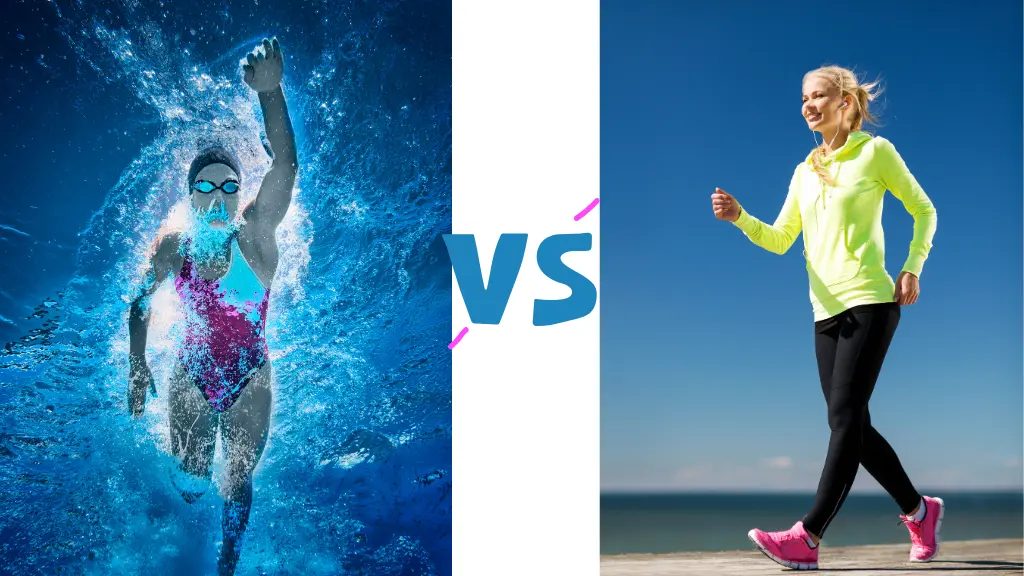When it comes to exercise, swimming and running are two of the most popular choices. Both offer significant benefits for cardiovascular health, endurance, and overall fitness. But which one is better for your body?
The answer depends on your goals, fitness level, and preferences. Let’s dive into the benefits of each and help you decide which suits you best.
You May Also Like: Want to Live a Long and Fulfilling Life?
1. Cardiovascular Benefits
Both swimming and running are exceptional cardiovascular exercises. They improve heart health, boost circulation, and increase lung capacity.
Running:
- Running is a high-impact activity that quickly raises your heart rate.
- It strengthens the heart muscle and improves endurance over time.
- Consistent running can help lower blood pressure and reduce the risk of heart disease.
Swimming:
- Swimming is a full-body workout that enhances cardiovascular efficiency.
- The water resistance adds intensity, making your heart work harder without high impact.
- It’s especially beneficial for lung health, as it trains you to control your breathing.
Winner: Both are excellent for heart health. If you prefer low-impact activities, swimming is a better choice.
2. Full-Body Engagement
One major difference between swimming and running lies in how they engage your muscles.
Running:
- Primarily focuses on lower-body muscles, such as the glutes, quads, and calves.
- Activates core muscles for balance and stability.
- Offers less upper-body engagement.
Swimming:
- A full-body workout, engaging arms, shoulders, core, and legs.
- Builds lean muscle mass due to the resistance of water.
- Improves flexibility and joint mobility.
Winner: Swimming takes the lead for total-body muscle engagement.
3. Impact on Joints
The impact of exercise on joints is an important consideration, especially for individuals with injuries or arthritis.
Running:
- High-impact activity that can stress joints, particularly in the knees and ankles.
- Over time, improper form or overtraining may lead to injuries like shin splints or runner’s knee.
- Best for individuals with healthy joints and proper running shoes.
Swimming:
- Low-impact exercise that is gentle on joints.
- The buoyancy of water reduces stress, making it ideal for people with arthritis or recovering from injuries.
- A safer option for long-term joint health.
Winner: Swimming is the clear winner for joint-friendly exercise.
4. Calorie Burn and Weight Loss
If weight loss is your goal, both swimming and running can help you shed pounds. However, calorie burn depends on factors like intensity, duration, and body weight.
Running:
- Burns approximately 600–1,000 calories per hour for a person weighing 155 pounds.
- Running at higher speeds or on inclines increases calorie expenditure.
- Offers a quick and effective calorie burn for those short on time.
Swimming:
- Burns approximately 400–700 calories per hour for the same individual.
- Intense strokes like butterfly or freestyle can rival running in calorie burn.
- Offers a sustainable and enjoyable way to burn calories without stressing the body.
Winner: Running burns more calories in less time, but swimming is better for long sessions.
5. Mental Health Benefits
Exercise is not just about the body—it’s also about the mind. Both activities release endorphins, improving mood and reducing stress.
Running:
- Known for the “runner’s high,” a surge of endorphins that enhances mood.
- Outdoor running connects you with nature, boosting mental clarity.
- Helps relieve anxiety and improve sleep quality.
Swimming:
- The rhythmic nature of swimming promotes relaxation.
- Being in water can reduce stress and provide a meditative effect.
- Ideal for clearing your mind and improving focus.
Winner: Both are great, but swimming’s soothing nature makes it a standout for stress relief.
6. Accessibility and Convenience
The practicality of an exercise often determines how consistent you’ll be.
Running:
- Can be done almost anywhere, with minimal equipment needed.
- Perfect for people who enjoy exercising outdoors or while traveling.
- Weather can be a limiting factor, especially in extreme heat or cold.
Swimming:
- Requires access to a pool, lake, or ocean.
- Equipment like swimsuits, goggles, and swim caps may be necessary.
- Ideal for those with year-round pool access or living near water.
Winner: Running wins for convenience and accessibility.
7. Longevity and Sustainability
Sustainability is key to long-term fitness. The ability to maintain your chosen activity as you age matters.
Running:
- High-impact nature can lead to injuries, making it harder to sustain over decades.
- Aging runners often need to reduce intensity or switch to lower-impact alternatives.
Swimming:
- Gentle on the body, making it sustainable for all ages.
- Often recommended for older adults and those recovering from injuries.
- Builds strength and flexibility that support longevity.
Winner: Swimming is better for long-term fitness sustainability.
8. Cost
The cost of an exercise can also impact your choice.
Running:
- Requires only a good pair of running shoes.
- No memberships or special equipment needed.
Swimming:
- Pool memberships or entry fees can add up.
- Equipment like swimsuits and goggles has an initial cost.
Winner: Running is the more budget-friendly option.
Which Should You Choose?
Your choice depends on your goals and preferences:
- Choose Running If: You want a high-impact workout, need to burn calories quickly, or enjoy outdoor cardio.
- Choose Swimming If: You prefer low-impact exercise, want a full-body workout, or need joint-friendly activities.
The Bottom Line
Both swimming and running offer incredible benefits for your body and mind. Whether you choose to dive into the pool or hit the pavement, the key is consistency. Find the activity that motivates you, fits your lifestyle, and supports your fitness goals.
So, what will it be? Will you run your way to fitness or swim toward better health?











